The Intel Xeon W-3175X Review: 28 Unlocked Cores, $2999
by Ian Cutress on January 30, 2019 9:00 AM ESTCPU Performance: Encoding Tests
With the rise of streaming, vlogs, and video content as a whole, encoding and transcoding tests are becoming ever more important. Not only are more home users and gamers needing to convert video files into something more manageable, for streaming or archival purposes, but the servers that manage the output also manage around data and log files with compression and decompression. Our encoding tasks are focused around these important scenarios, with input from the community for the best implementation of real-world testing.
All of our benchmark results can also be found in our benchmark engine, Bench.
For our graphs, some of them have two values: a regular value in orange, and one in red called 'Intel Spec'. ASUS offers the option to 'open up' the power and current limits of the chip, so the CPU is still running at the same frequency but is not throttled. Despite Intel saying that they recommend 'Intel Spec', the system they sent to us to test was actually set up with the power limits opened up, and the results they provided for us to compare to internally also correlated with that setting. As a result, we're providing both sets results for our CPU tests.
Handbrake 1.1.0: Streaming and Archival Video Transcoding
A popular open source tool, Handbrake is the anything-to-anything video conversion software that a number of people use as a reference point. The danger is always on version numbers and optimization, for example the latest versions of the software can take advantage of AVX-512 and OpenCL to accelerate certain types of transcoding and algorithms. The version we use here is a pure CPU play, with common transcoding variations.
We have split Handbrake up into several tests, using a Logitech C920 1080p60 native webcam recording (essentially a streamer recording), and convert them into two types of streaming formats and one for archival. The output settings used are:
- 720p60 at 6000 kbps constant bit rate, fast setting, high profile
- 1080p60 at 3500 kbps constant bit rate, faster setting, main profile
- 1080p60 HEVC at 3500 kbps variable bit rate, fast setting, main profile
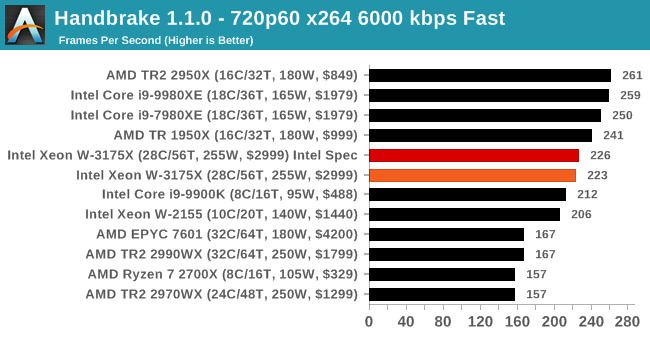
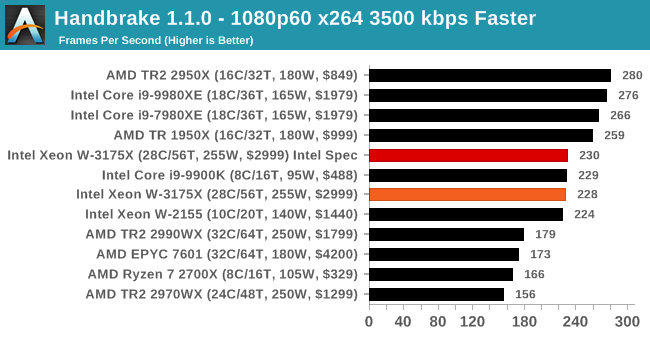
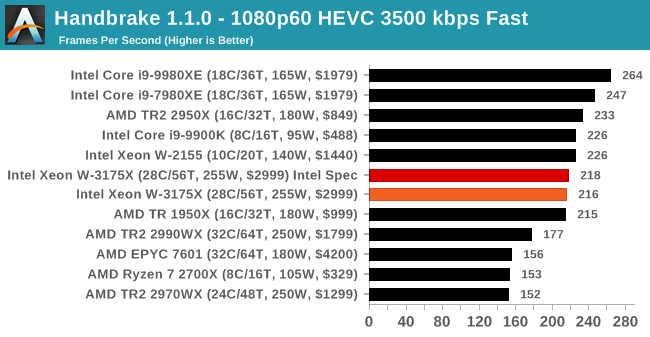
.
7-zip v1805: Popular Open-Source Encoding Engine
Out of our compression/decompression tool tests, 7-zip is the most requested and comes with a built-in benchmark. For our test suite, we’ve pulled the latest version of the software and we run the benchmark from the command line, reporting the compression, decompression, and a combined score.
It is noted in this benchmark that the latest multi-die processors have very bi-modal performance between compression and decompression, performing well in one and badly in the other. There are also discussions around how the Windows Scheduler is implementing every thread. As we get more results, it will be interesting to see how this plays out.
Please note, if you plan to share out the Compression graph, please include the Decompression one. Otherwise you’re only presenting half a picture.
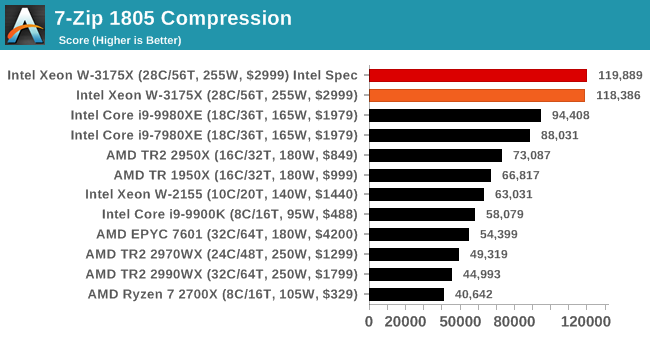
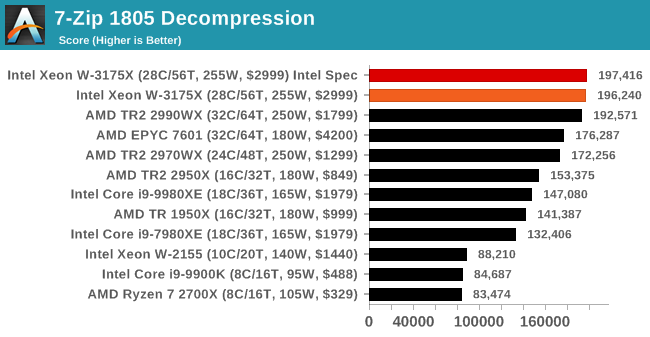
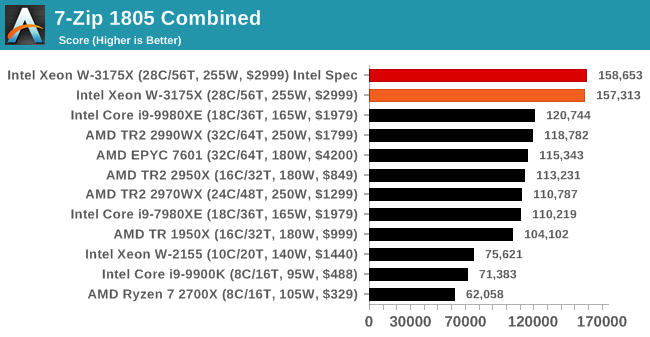
.
WinRAR 5.60b3: Archiving Tool
My compression tool of choice is often WinRAR, having been one of the first tools a number of my generation used over two decades ago. The interface has not changed much, although the integration with Windows right click commands is always a plus. It has no in-built test, so we run a compression over a set directory containing over thirty 60-second video files and 2000 small web-based files at a normal compression rate.
WinRAR is variable threaded but also susceptible to caching, so in our test we run it 10 times and take the average of the last five, leaving the test purely for raw CPU compute performance.
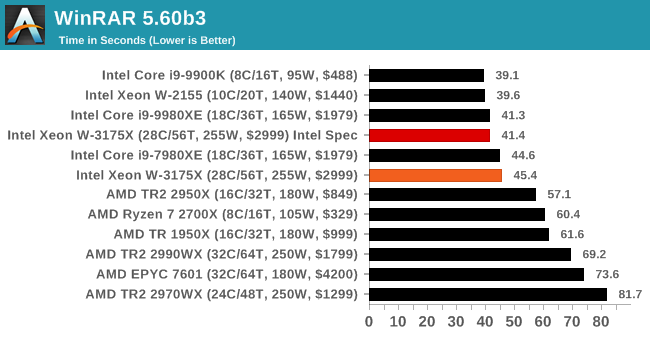
.
AES Encryption: File Security
A number of platforms, particularly mobile devices, are now offering encryption by default with file systems in order to protect the contents. Windows based devices have these options as well, often applied by BitLocker or third-party software. In our AES encryption test, we used the discontinued TrueCrypt for its built-in benchmark, which tests several encryption algorithms directly in memory.
The data we take for this test is the combined AES encrypt/decrypt performance, measured in gigabytes per second. The software does use AES commands for processors that offer hardware selection, however not AVX-512.
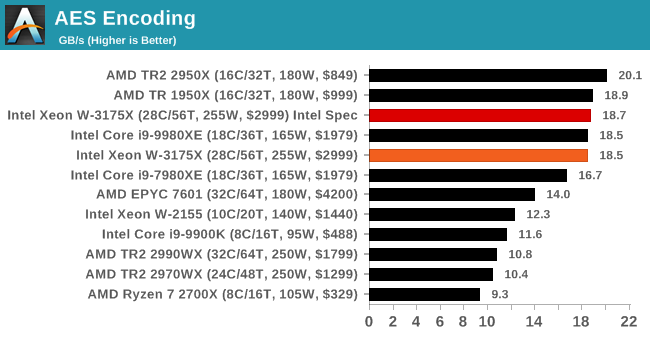
.










136 Comments
View All Comments
FMinus - Friday, February 1, 2019 - link
Not really, 3D rednering is done on specialized render farms, the modeling work, key framing etc. can be done on any decent modern mainstream CPU, and especially well on any modern HEDT chip, for prototyping and preview, once satisfied, send it out to render properly.eastcoast_pete - Wednesday, January 30, 2019 - link
The only scenario where this or similar Xeons do outperform the AMD lineup is if (!) the key application (s) in question make good use of AVX512. In those situations, Intel is still way ahead. In all others, a similar or lower priced Threadripper will give more bang for the buck.Tango - Wednesday, January 30, 2019 - link
There are scenarios in which this is perfect, and in fact my research department is looking into acquiring two of them. Our algorithms include both highly parallelized instructions and completely non parallelizable ones where clock speed dominates. We estimate models that take a whole weekend to spot out a result, and the alternative is paying top money for supercomputer time.At $3000 it is a steal. The problem is half Wall Street will be sending orders to get one, since the use case is similar for high frequency trading applications.
MattZN - Wednesday, January 30, 2019 - link
I expect all the review sites will redo their 2990WX benchmarks once Microsoft is able to fix the scheduler. The question is really... how long will it take Microsoft to fix their scheduler? That said, nobody should be expecting massive improvements. Some of the applications will improve a ton, but not all of them. It will be more like a right-sizing closer to expected results and less like hitting the ball out of the park.-Matt
BGADK - Wednesday, January 30, 2019 - link
Little professional software exists for Linux, so these machines WILL run windows for most parts.cmcl - Thursday, January 31, 2019 - link
Agree that there is more professional software for Windows, but in visual effects (where I work), 90% of our workstations (and all render) runs on Linux (24-core workstations, with P6000s), running Nuke, Maya etc. Apart from the gaming benchmarks (and who would buy one of these for gaming), a lot of the tests could be done in Linux as that software runs on LinuxIcehawk - Thursday, January 31, 2019 - link
Workstations aside, these mega-core beasts are run as VM hosts on bare metal. I don't have a single server here that just runs an OS & app suite, it's not 2000 anymore everything is virtualized as much as possible.WasHopingForAnHonestReview - Wednesday, January 30, 2019 - link
Holy shit. AMD absolutely bent intel over on this one. The price for performance ratio is overwhelming in AMD ls favor! Intel would have released this for 8k if the 2990wx wasnt so competitive!WOW!
GreenReaper - Thursday, January 31, 2019 - link
They probably wouldn't have released it at all. As noted, most of these could easily be server cores on which they could make plenty more money. This appears to be largely a PR effort.jcc5169 - Wednesday, January 30, 2019 - link
Who in the world would buy this over-priced piece-of-crap?